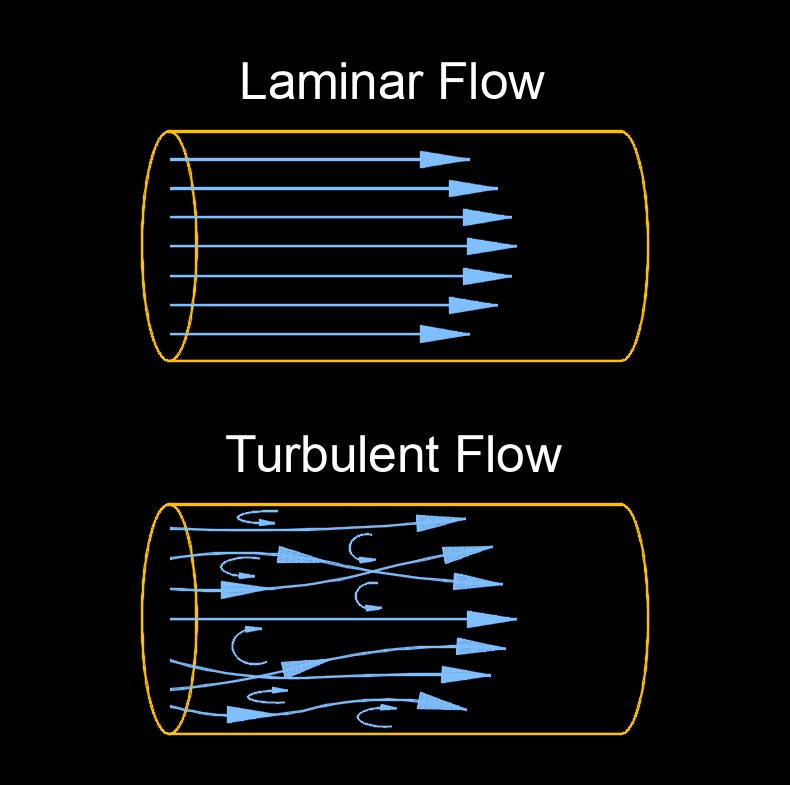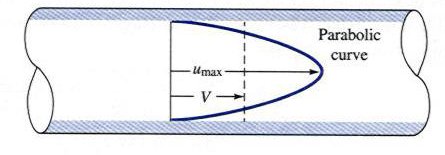 Laminar flow generally happens when dealing with low Reynolds numbers in pipes. Laminar flow, also known as streamline flow, is a type of fluid flow in which the fluid moves in parallel layers, with no or minimal mixing between the layers. In laminar flow, the fluid particles move smoothly and steadily along fixed paths, without any turbulence or eddies. Laminar flow occurs when the fluid moves slowly and the viscosity of the fluid is high enough to prevent turbulence from developing. It is often described as a well behaved flow, as it is predictable and easy to analyze mathematically.
Laminar flow generally happens when dealing with low Reynolds numbers in pipes. Laminar flow, also known as streamline flow, is a type of fluid flow in which the fluid moves in parallel layers, with no or minimal mixing between the layers. In laminar flow, the fluid particles move smoothly and steadily along fixed paths, without any turbulence or eddies. Laminar flow occurs when the fluid moves slowly and the viscosity of the fluid is high enough to prevent turbulence from developing. It is often described as a well behaved flow, as it is predictable and easy to analyze mathematically.
One of the key characteristics of laminar flow is that the velocity of the fluid is constant across any given cross-section of the flow. This means that there is no net flow of fluid in any direction perpendicular to the direction of flow. Laminar flow is important in many areas of science and engineering, including fluid dynamics, chemical engineering, and aerospace engineering. It is often used in situations where a smooth, controlled flow of fluid is required, such as in the design of pipes, valves, and pumps, as well as in the development of new materials and technologies.
Shear stress in laminar flow is independent of the density - ρ, and the shear stress depends almost only on the viscosity - μ.

Key Points about Laminar Flow
Smooth and Ordered - Laminar flow is characterized by the smooth and orderly movement of fluid particles along parallel paths. Each particle moves without disruption or mixing with neighboring particles.
Distinct Layers - The fluid flows in distinct layers, known as laminae, with minimal mixing or turbulence between them.
Low Velocity - Laminar flow typically occurs at low velocities, where viscous forces dominate over inertial forces.
Viscous Dominance - In laminar flow, viscous forces within the fluid dominate, resulting in the formation of laminar layers.
Predictable Behavior - Laminar flow is highly predictable, allowing for precise calculations of fluid behavior and flow rates.
Applications - Laminar flow is commonly observed in small scale systems with smooth surfaces, such as the flow of
liquids through narrow tubes, microfluidic devices, and certain industrial processes.
Efficient Heat Transfer - Laminar flow can be advantageous for
heat transfer applications since it minimizes mixing and allows for efficient transfer of
heat between a fluid and its surroundings.
Low Energy Dissipation - Compared to turbulent flow, laminar flow experiences lower levels of
energy dissipation due to reduced turbulence.
Stable Conditions - Laminar flow tends to maintain stable conditions over time, provided there are no significant changes in flow rate or system parameters.
Transition to Turbulence - Laminar flow may transition to turbulent flow under certain conditions, such as increasing flow velocity or encountering irregularities in the flow path.

 Laminar flow generally happens when dealing with low Reynolds numbers in pipes. Laminar flow, also known as streamline flow, is a type of fluid flow in which the fluid moves in parallel layers, with no or minimal mixing between the layers. In laminar flow, the fluid particles move smoothly and steadily along fixed paths, without any turbulence or eddies. Laminar flow occurs when the fluid moves slowly and the viscosity of the fluid is high enough to prevent turbulence from developing. It is often described as a well behaved flow, as it is predictable and easy to analyze mathematically.
Laminar flow generally happens when dealing with low Reynolds numbers in pipes. Laminar flow, also known as streamline flow, is a type of fluid flow in which the fluid moves in parallel layers, with no or minimal mixing between the layers. In laminar flow, the fluid particles move smoothly and steadily along fixed paths, without any turbulence or eddies. Laminar flow occurs when the fluid moves slowly and the viscosity of the fluid is high enough to prevent turbulence from developing. It is often described as a well behaved flow, as it is predictable and easy to analyze mathematically.

